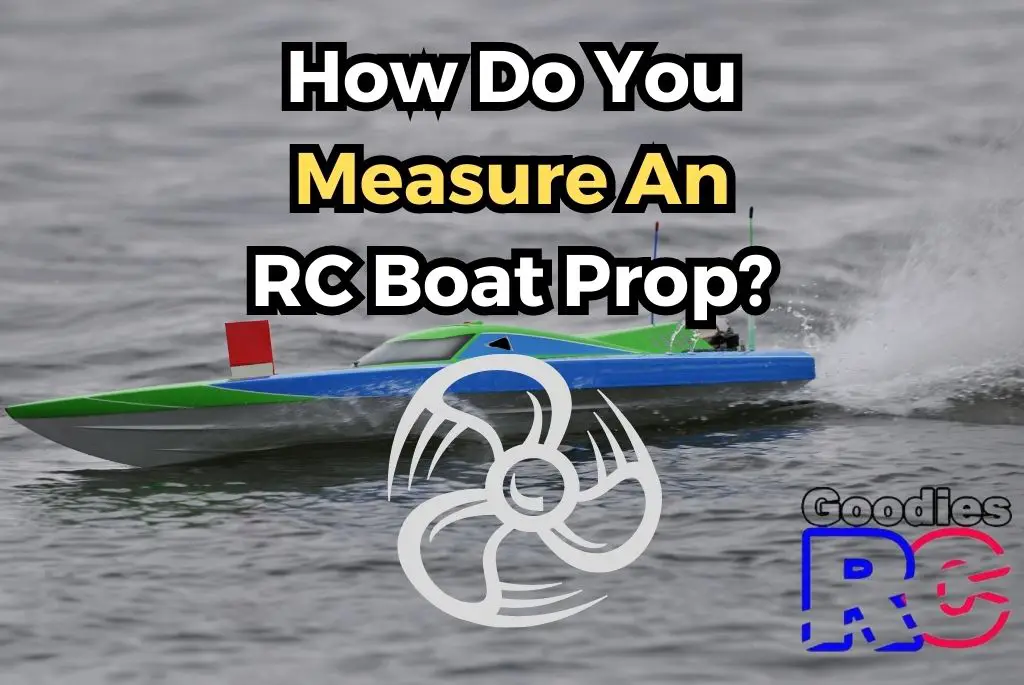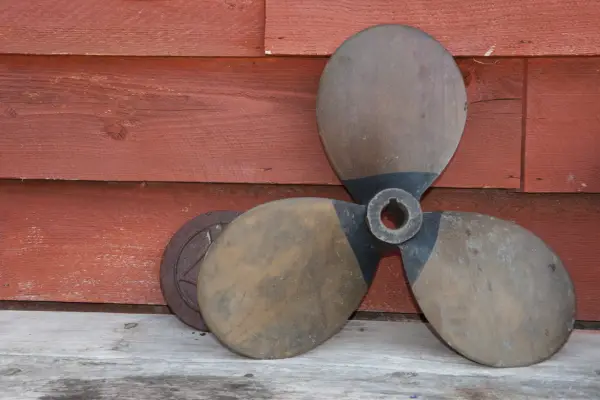Remote Control (RC) boats are very popular and offer a lot of thrills and fun for many, even landlubbers. With these RC boats, the key is to select the right prop to ensure the boat travels well and not damaging the motors. How do you measure an RC boat prop?
To measure an RC boat prop, start by measuring the propeller diameter. Then measure the propeller’s pitch. These could be done using a ruler or a caliper. Measuring diameter and pitch helps to ensure you select the right prop to match your boat, motor, and style.

In this article, we explore how you can measure an RC boat prop. We also look at other factors that could affect your final decision on the propeller size for your RC boat.
What Is A RC Boat Prop?
A prop (propeller) is a component in an RC boat. Its job is to propel the RC boat forward through water by rotating itself underwater. An RC boat prop also works similarly to a full-size boat’s propeller.
A prop is made of several fan blades that connect in the center. As it spins, it can drive the RC boat forward or backward. The rotation is usually powered by an onboard motor, spinning the propeller shaft, which spins the propeller.
RC boat props could be made of many materials, depending on price, quality, and performance requirements. Popular materials include aluminum, stainless steel, and plastic.
RC boat props can also come in several designs, with some having two blades and some three. Choosing the right prop for your RC boat is important to ensure maximum performance.
How Do You Measure A RC Boat Prop?
The first step to ensure you select the right prop for your RC boat is to get the right propeller diameter and pitch. To do this, you must first know how to measure them:
Propeller Diameter
The diameter of a prop points to how big it is. You measure it from the two outermost points of the propeller blades. To measure the diameter of your propeller:
- Detach the propeller from its shaft and lay it horizontally on a flat surface.
- Place a ruler or a caliper horizontally. Ensure it crosses the center of the propeller hub.
- If you are using a caliper, clamp in and ensure your grip on both ends of the propeller is right. The reading on your caliper tells you the diameter of your prop.
- With a ruler, simply read the ruler on one end of the prop to determine the diameter.
Propeller Pitch
While the prop diameter is easy to measure, the pitch can also be a little hard to understand and measure. A propeller’s pitch points to the distance your RC boat will travel with each full rotation of the propeller under still, steady water.
Get the idea? Good. Let’s go measure, then. If not, take your time and reread the explanation again until you get it.
To measure your RC boat prop’s pitch:
- Start by marking the reference point. Select one blade on your prop, and make a small mark with a marker near the tip.
- Ensure the mark is easily visible and won’t be erased or smudged.
- Position the propeller vertically, with the marked blade facing up.
- Hold on to the boat to prevent movement. This helps you to get a better measurement.
- Now, carefully rotate the propeller by hand, making one full 360° turn. Ensure that the rotation is smooth and steady.
- As you rotate the propeller, observe the forward distance the reference point covers from its starting position to the final point when it fully rotates.
- Use a ruler or tape measure to measure the forward distance traveled by the reference point.
- This measurement is the pitch of the propeller. You usually express the pitch of an RC boat propeller in inches or centimetres.
Are There Other Factors That Influence RC Boat Prop Choice?

Aside from prop diameter and pitch, other factors should be considered when choosing your RC boat prop. These include, but are not limited to:
Boat Weight
If you have a heavy RC boat, you may need more thrust from your propeller to move quickly and reach higher speeds faster. In this case, you may need a propeller with a larger diameter and higher pitch.
If you have a sluggish RC boat that just can’t seem to pick up the speed, then remember that the problem may also lie with the prop. See this detailed guide on how to sharpen and balance your RC boat propeller for optimal performance.
Motor Strength
The more powerful your RC boat onboard motor is, the more torque it can generate. It should also generate high RPMs (Revolutions Per Minute).
This means the more motor strength you have, the larger propeller diameter you can work with, and pitch too. However, if your onboard motor is battery-powered, remember that larger propellers may drain your battery faster.
Interested in maximizing the performance of your RC boat? Check out our guide on the best RC gas boat engines to find top recommendations and installation tips.
Shaft Size
When choosing a prop for your RC boat, ensure the shaft size is suitable. As a start, you must first ensure that the shaft size fits your prop and the motor.
You also want to ensure the shaft size does not affect your motor’s RPM capability. In many cases, oversized shafts may be too heavy for the motor, which may cause its RPM to drop.
Note: Ever faced issues with your RC boat? Don’t worry; our guide on how to fix common RC boat problems can help you troubleshoot the issue.
Prop Shape
When choosing the prop for your RC boat, take note of its shape too. When it comes to shape, you will be looking at how many blades your prop has. You also are deciding between cupped or raked prop blades.
Blade Numbers: Generally, two-blade props produce higher speeds, making them popular with high-speed, racing RC boats. Four-blade props are stable, making them popular with scaled boat models. Three-blade props offer a balance between two and four-blade props.
Cupped or Raked Blades: Cupped blades have a curved cup shape at the blade tips. This design helps with performance by giving a better grip on the water. Raked blades slant backward instead. This design reduces cavitation and improves efficiency.
Wrapping Up
In this post, we looked at how to measure your RC boat prop in diameter and pitch. We also looked at other factors when choosing your RC boat prop.
If you are checking out RC boat propellers, chances are you are building your own RC boat. In this case, feel free to check out our guide on the parts you need to build an RC boat.
